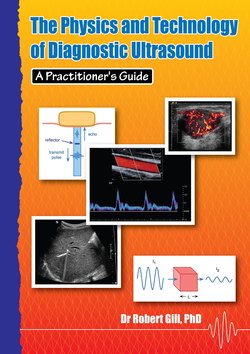Читать книгу The Physics and Technology of Diagnostic Ultrasound: A Practitioner's Guide - Robert Gill - Страница 17
На сайте Литреса книга снята с продажи.
Chapter 2: Ultrasound interaction with tissue Ultrasound waves and propagation
ОглавлениеUltrasound is simply very high frequency sound. Audible sound frequencies range from around 20 Hz to 20 kHz, whereas diagnostic ultrasound ranges from 2 MHz to 15 MHz, that is around 1000 times higher in frequency. We will see that these high frequencies are used to provide the best possible image resolution (i.e. ability to image small structures).
Like sound, an ultrasound wave consists of oscillating pressure variations. These are caused by vibration (at the ultrasound frequency) of the ultrasound transducer against the skin surface (see Figure 2.1). When the transducer is moving towards the body it compresses the tissues, causing an increase in pressure ("compression"). When it moves away from the body it decompresses the tissues, causing a decrease in pressure ("rarefaction"). In this way oscillating changes of pressure are created. These pressure variations constitute an ultrasound wave which travels through the tissues at a constant speed.
Figure 2.1 Oscillation of the transducer face against the skin creates an ultrasound wave travelling into the tissues.
Since the movement of individual particles and the movement of the energy in the wave are both in the same direction (vertically down into the tissue) the ultrasound wave is called a longitudinal wave. In this way ultrasound waves differ from ocean waves. They are called transverse waves since the wave travels horizontally along the surface of the ocean but individual particles of water move vertically.
If we were able to focus on a single point in the tissues, we would see the pressure oscillating in time (see Figure 2.2), increasing and decreasing equally above and below the mean pressure in the tissue.
Figure 2.2 Tissue pressure at one point as a function of time. Note the definitions of the period of the wave (T) and its amplitude (A).
Two important parameters are defined in this figure. The amplitude (A) is the maximum variation of the pressure from its mean value in the tissues. It determines the amount of energy in the ultrasound wave and therefore the level of exposure of the tissues. Useful measures of exposure are the transmitted power (transmitted energy per second) and the intensity at a given point. Tissue exposure will be discussed in more detail in chapter 11.
The period (T) is the time between one cycle and the next. It is related to the ultrasound frequency (f) (i.e. the number of cycles per second) as follows:
We can also imagine a situation where we could look at the variation of pressure as a function of depth into the tissue at one instant in time. (This is similar to taking a photograph of ocean waves at one instant.) We would find a similar pattern of pressure variations with depth into the tissues, as shown in Figure 2.3.
Figure 2.3 Tissue pressure at one instant as a function of depth into the tissues. Note the definition of the wavelength (λ).
This figure shows the definition of a particularly important parameter, the wavelength (λ), which is the physical length of a single cycle (comparable to the distance from the top of one ocean wave to the top of the next one).
Linking these two views – the temporal (i.e. time) variation of the wave in Figure 2.2 and its spatial variation in Figure 2.3 – is the propagation speed of ultrasound in the tissues (conventionally represented by the symbol c). In normal soft tissue it has a value of 1540 m/sec. We will see in chapter 6 that the propagation speed does vary somewhat, since its exact value in a given tissue is determined by the tissue's density and stiffness and these vary from one tissue to another.
A simple equation describes the relationship between propagation speed, frequency and wavelength:
c = f λ
This equation can be rearranged to allow the wavelength for a given frequency to be calculated:
Table 2.1 lists a number of typical ultrasound frequencies and wavelengths in soft tissue (assuming c = 1540 m/sec).
Table 2.1 Typical frequencies used in diagnostic ultrasound and the corresponding wavelengths in soft tissue.
| Frequency (MHz) | Wavelength (mm) |
|---|---|
| 2 | 0.77 |
| 3 | 0.51 |
| 5 | 0.31 |
| 8 | 0.19 |
| 10 | 0.15 |
| 15 | 0.10 |
Notice that for all frequencies the wavelength is less than 1 mm. Also notice that the wavelength becomes smaller as the frequency increases.
It will become clear that the resolution of an ultrasound image is directly related to the wavelength – the smaller the wavelength the better the resolution. Given the inverse relationship between frequency and wavelength this means that:
The higher the frequency the better the resolution.
Unfortunately we will shortly see that it is not possible to keep increasing the frequency to achieve ever better resolution. The physics of ultrasound places a limit on the frequency that can be used in a given clinical situation.
